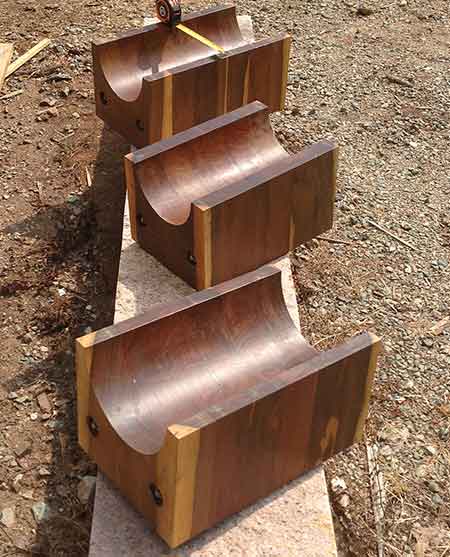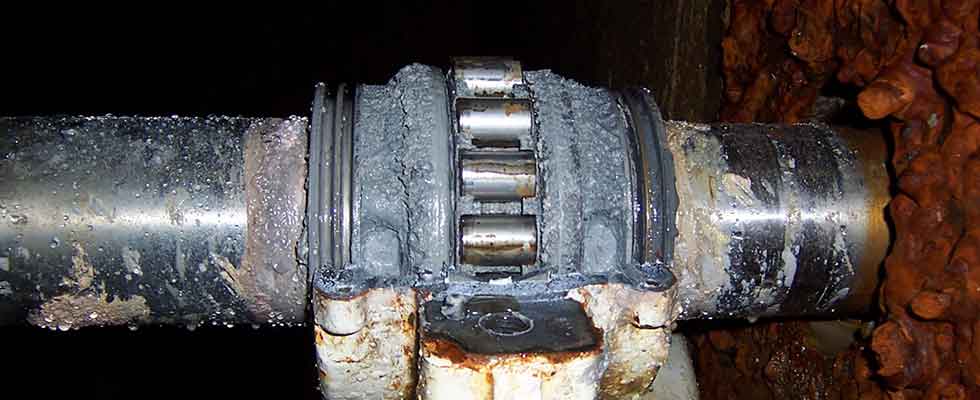
Water-lubricated bearings are in use across many industries including hydropower, marine, offshore, pump, large diameter deep wells and petrochemical (where spark-free operation is imperative), water purification and sanitation.
In all environments, all bearings have issues over time. Water-lubricated bearings present specific challenges to the bearing, and abrasive water brings another level of challenges.
The purpose of any bearing material is to act as a sacrificial interface between a fixed unit and a rotating shaft. The bearing material must not possess too much stiction—the static friction that must be overcome to enable relative motion of stationary objects in contact—and be stiff enough to withstand the loads, but not so hard as to score the rotating shaft. Bearing selection is critical when considering these properties.
Whether the bearings are metal, polymer/plastic or a natural material, they should run smoothly and avoid maintenance between planned outages. Here are key considerations to keep in mind when deciding the type of bearing to use.

Friction
Knowing that reducing friction is the end goal, finding a material that has a self-lubricating glaze to break friction and then readily transition to a hydrodynamic state is ideal. Finding materials that allow just the runner and the bearing itself with no internal ball bearings, rollers or other moving parts is better.
Metal bearings such as bronze, brass and babbitt have the highest coefficient of friction (COF) on startup and are generally not employed under water. Metals, including hard steel roller bearings, rely solely on a fluid film of oil or grease to operate, which makes them difficult to seal properly in a water environment. An oiled bearing configuration has two major risks: first, spilling oil into the water, and then second, failure if just 2 percent water intrusion takes place.
The chemistry of plastics and polymers is an ongoing experiment with more than 20 formulas. Plastic/polymer materials generally have a low COF but can have long-term “creep and swelling,” which can cause shafts to labor to overcome increasing operating friction or seize entirely. Additionally, abrasives in typical river water can lead to inordinate wear and failures of these materials. Most plastics and polymers rely on large clearances that allow premature wear and egg-shaped wear patterns on the bottom of the bearing.
The natural materials lignum vitae and rubber were both introduced as suitable bearing material in the mid-1800s and have been used since then. Lignum vitae has a low COF and rubber has a high COF, but both overcome stiction when water is present. One property of lignum vitae is its guaiacum resin that creates a glaze that allows it to self-lubricate as water is pumped to the bearing. It is this characteristic that allows lignum vitae to operate in deep wells as water is drawn up from below to cover the bearing.
High Compression Strength
The bearing material should have high compressive strength to prevent extrusion of material and withstand edge loading. Low compressive strength may cause yielding and excessive clearance.
High Fatigue Strength
High fatigue strength or toughness is desirable to avoid surface cracks in metal and hydrolysis in plastics, where water breaks down the chemical bonds. Hydrolysis leads to deterioration of the plastic and the introduction of contaminants. A key feature of the natural materials rubber and lignum vitae is high elasticity and toughness that allows impurities to migrate and flush away in the coolant water channel. The molecular structure and high density of lignum vitae bound in a cellular structure surrounded by guaiacum resin gives it a distinct toughness. Owing to its hardness, which is similar to aluminum, lignum vitae can deal with abrasives in brown water without filtering.

Low Thermal Expansion
This ensures the dimensions of the bearing will remain constant during periods of temperature change.
Elasticity
Bearing material should be elastic enough to allow the bearing to return to original shape upon relief of stress that may cause temporary distortion, misalignment and overloading. Many shafts are not perfect. This gives the shaft a cam effect that may cause a hammering on the bearing, making memory an important characteristic.
Conformability
Conformability is important when shafts are scored or pitted. Metal bearings have little to no ability to conform and plastics can smear, melt or wipe material onto the shaft. Lignum vitae and rubber will conform to imperfections versus wearing or melting away.
Embeddability
Unlike babbitts, which rely on the bearing metal to entrap impurities, water-lubricated bearings must resist embedding foreign materials so they can be flushed away. At operating temperatures, the guaiacum resin in lignum vitae creates a glaze that makes it nearly impervious to embedding foreign materials.
Corrosion Resistance
From the onset, select materials that do not create galvanic corrosion because of employing dissimilar metals between the journal and the bearing. If it is possible, select a nonconductive bearing as they completely avoid electrolysis.
Consider the environment that the bearing will be used in. Bearings must readily tolerate everything from brown water to ocean water and even severe environments either acidic or alkaline and be completely resistant to corrosion.
Availability
Availability of bearings has become difficult considering many are manufactured overseas making “just-in-time delivery” more challenging. Bearing selection must consider if a bearing will be where it is needed when it is needed.
Environmental
In light of current United States Environmental Protection Agency (EPA) regulations, National Sanitation Foundation (NSF) 61 requirements and general toxicity concerns, environmental awareness needs to be part of the bearing selection. Metal bearings require mining, refining and recycling arrangements. Plastics/polymers require oil extraction, refining and toxic chemicals in their manufacture, and as a result, these materials require more considerations for disposal. The primary advantage of the natural materials, rubber and lignum vitae, is the benefit of being renewable. Lignum vitae is ready as is for machining and immediate use and has no disposal concerns. Latex saps must be processed to become rubber, and there are disposal considerations with rubber.
Cost
When selecting a bearing, it is important to not just consider the initial cost. The full cost of use includes periodic adjustments and anticipated replacements. Making a replacement can be a large undertaking and likely includes major preparations to get access to the bearing and the labor to remove and change it out. Replacement costs exist for both planned and unplanned outages, so the history of repair and maintenance along with longevity and reliability are important considerations in analyzing full cost. When unplanned outages do occur, there is the added expense of lost revenue. All of these considerations must be taken together to properly assess the true value of a bearing. Bearing selection is critical and it could not be truer than when considering full cost of use. With proper selection, water-lubricated bearings can last for decades, providing clean, oil-free operation in everything from pumps to aircraft carriers.

